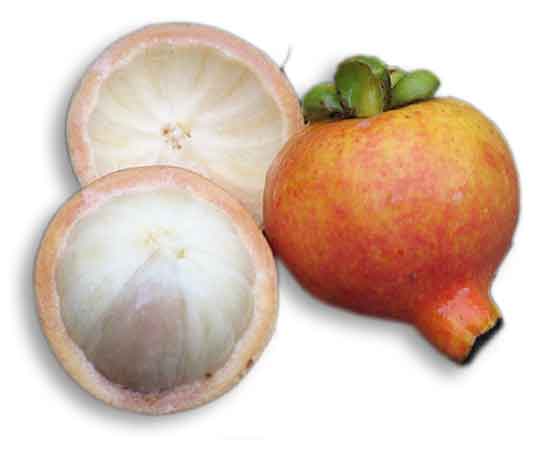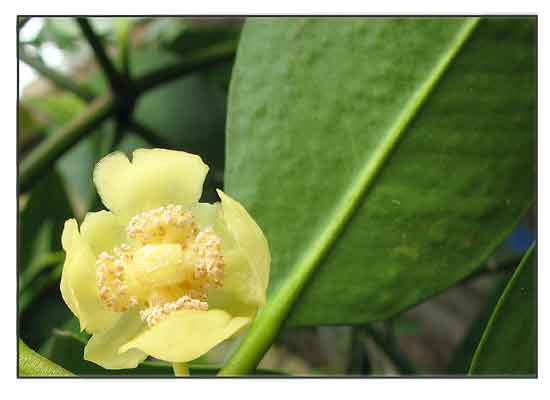 Gen info Gen info
- Garcinia is a genus of flowering plants in the family Clusiaceae, native to Asia, America, Australia, tropical and southern Africa, and Polynesia. While the number of species is disputed, Plants of the World Online lists up to 400 species. The plants are usually called saptrees, mangosteens (which may refer specifically to Garcinia mangostana), or garcinias. Some plants are also known as "monkey fruit". (2)
- Etymology: The genus name Garcinia is named after French botanist Laurent Garcin (1683-1751).
(2)
Botany
(Note: No botanical information found specifically for Garcinia lateriflora.) Trees or shrubs, mostly glabrous, with translucent glandular canals or brownish resin canals and yellow opaque exudate. Leaves opposite, entire, lateral nerves numerous, close and parallel or ± distant, usually branched, alternating with the glandular canals but crossed by resin canals. Inflorescence terminal or axillary, cymose. Flowers usually polygamous or plants dioecious. Sepals 4-5, imbricate or decussate. Petals 4 or 5, greenish-white to yellow, imbricate, equilateral, deciduous in female flowers. Stamens in 4 or 5 antepetalous fascicles or apparently not fascicled, many, filaments slender to stout, free or ± united or fascicles ± united to form a lobed or conical synandrium; anthers dorsifixed or ± immersed in a synandrium, dehiscing variously, without gland on connective; staminodes various or absent; sterile fascicles present and free or united, or absent. Ovary 2-5(-12)-locular, placentae axile, each placenta 1-ovulate, in male flowers rudimentary or absent; styles absent or very short; stigmas 2-5(-12)-lobed, peltate, or forming a uniform mass. Fruit a 1-4-seeded fleshy berry, with tough epidermis; seeds large.
(Garcinia: Norman K B Robson)
Distribution
- Native to the Philippines
- Also native to Jawa, Lesser Sunda Is., Sulawesi.
 Constituents Constituents
- Study of stem bark isolated a new biflavonoid, lateriflavanone (1), a new xanthone enantiomer, laterixanthone, (2), along with known compounds, morelloflavone (8), talbotaflavone (9), rhusflavanone, and stigma-5,13-diene 3ß-O-D-glucoside. Chromatographic separation of combined fractions 5 and 6 yielded new compounds, isomoreoliic acid (3), isogaudichaudiic acid (4), isogaudichaudiic acid E (5), 11,12-dihydro-12-hydroxymorellic acid (6), isogaudichaudiic acid B (7), along with known morellic acid (10) and 3ß-acetoxyurs-12-en-28-oic acid. (see study below) (6)
- Study of stem bark isolated a new triterpenoid named garcinin.
(9)
- Study isolated isogaudichaudic acid (CS 3.193), isogaudichaudic acid E (CS 3.194), 11,12-dihydro-12-hydroxymorellic acid (CS 3.195), and morellic acid (CS 3.196). (see study below) (10)
- Study isolated lateriflorone (1), a cytotoxic natural product with an unprecedented spiroxalactone skeleton, characterized by NMR and x-ray crystallography studies as 6,21-bis(3-methylbut-2-enyl)-19-hydroxy-2,2,23, 23-tetramethyl-13,15,22-trioxaspiro[6,7-dihydro-2H-chromene-7, 4'-tetracyclo[7.4.1.0(2,7).0(2,11)]tetradecane]-17-ene-5,8,16,20-tetraone. (11)
- Nutrient analysis of fruit per 100 g edible portion yielded:
Proximates: water 84.1 g, calculated energy 65 kcal, protein 0.3 g, total fat 0.5 g, total carbohydrate 14.9 g, total ash 0.2, total dietary fiber 4.6 g, total sugars 2.8 g; Minerals: calcium 32 mg, phosphorus 21 mg, iron 0.1 mg, potassium 64 mg, sodium 5 mg, zinc 0.2 mg; Vitamins: beta-carotene 1897 µg, retinol activity equivalent (RAE) 158 µg, thiamin (B1) 0.04 mg, riboflavin (B2) 0.02 mg, niacin 0.9 mg; Lipids: fatty acids 0, cholesterol 0. (DOST-FNRI) (4)
 Properties Properties
- Studies have suggested antioxidant, lipoxygenase inhibition, cytotoxic, alpha-glucosidase inhibitory properties.
Parts used
Leaves, stem bark.
Uses
Edibility
-Fruits are edible.
Folkloric
- No reported folkloric medicinal use in the Philippines.
Studies
• Antioxidant and Lipoxygenase Inhibition Activities / Leaves: Study evaluated the antioxidant and lipoxygenase inhibition activity of leaf extracts pf G. lateriflora using ferric reducing antioxidant power assay, in vitro assessment of lipoxygenase inhibition activity, and qualitative analysis of flavonoid content. Based on assessment for methanol, ethyl acetate, and n-hexane extracts, the effective concentration 50% level of antioxidant activity of leaves were 9.567, 16.555, and 50.550 µg/mL, respectively. IC50 levels of lipoxygenase inhibition activity were 0.693, 0.793, and 1.316 µg/mL, respectively. For both tests, the methanol extract was most active, which yielded a total flavonoid content of 6.298 mg quercetin equivalents/g. (5)
• Proteasone-Inhibitory / Cytotoxicity / Stem Bark: Study of stem bark isolated a new biflavonoid (1), a new xanthone enantiomer (2), five new caged xanthones (3-7) and several known compounds. The biflavoids exhibited proteasome inhibitory activity, with morelloflavone (8) showing greatest potency (IC50 1.3 µM). Caged xanthones were cytotoxic towards HT-29 cells, with morellic acid (10) being the most active (ED50 0.36 µM); however, on in vivo hollow fiber assay, it was inactive at highest dose tested (20 mg/kg). (6)
• Antioxidant / Leaves: Study evaluated the antioxidant effect of n-hexane, ethyl acetate and methanol extracts of G. lateriflora leaves. The methanol extract showed stronger antioxidant activity with EC50 of 13.95 and 19.65 µg/mL by DPPH and FRAP methods, respectively. E13 fraction was the most activity from the EA extract with EC50 of 37.14 µg/mL by DPPH scavenging method and 34.46 µg/mL for reducing power by FRAP method. (7)
• Alpha-Glucosidase Inhibitory Activity / Leaves: Fractionation of ethyl acetate and methanol extracts of leaves yielded 17 and 12 fractions, respectively. Fraction 13 (EA13) and 10 (ME10) showed highest percentage inhibition of alpha-glucosidase activity with IC50s of 8.96 µg/ml and 18.52 µg/ml, respectively, compared to acarbose with 39.53 µg/ml. (8)
• Cytotoxicity to HT-29 Cells: Garcinia lateriflora Blume produces isogaudichaudic acid (CS 3.193), isogaudichaudic acid E (CS 3.194), 11,12-dihydro-12-hydroxymorellic acid (CS 3.195), and morellic acid (CS 3.196), which were shown to be toxic to HT-29 cells, with IC50s of 3.2 µM, 2.6 µM, 2.9 µM, and 0.3 µM. (10)
• Alpha-Amylase Inhibitory Activity / Leaves: Study evaluated 13 species from the Clusiaceae family for α-glucosidase and α-amylase enzyme inhibition. n-Hexane extract of Garcinia lateriflora showed most potent α-amylase inhibition with IC50 of 14.9818 µg/mL, while ethyl acetate and methanol extract showed IC50s of 81.4539 and 98.5713 µg/mL, respectively. (12)
Availability
Wild-crafted.
Seeds in the cybermarket. |

![]()






